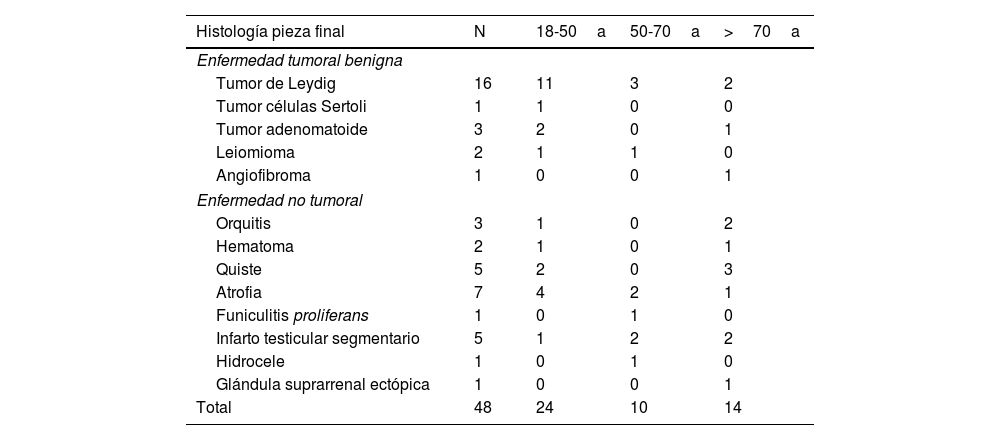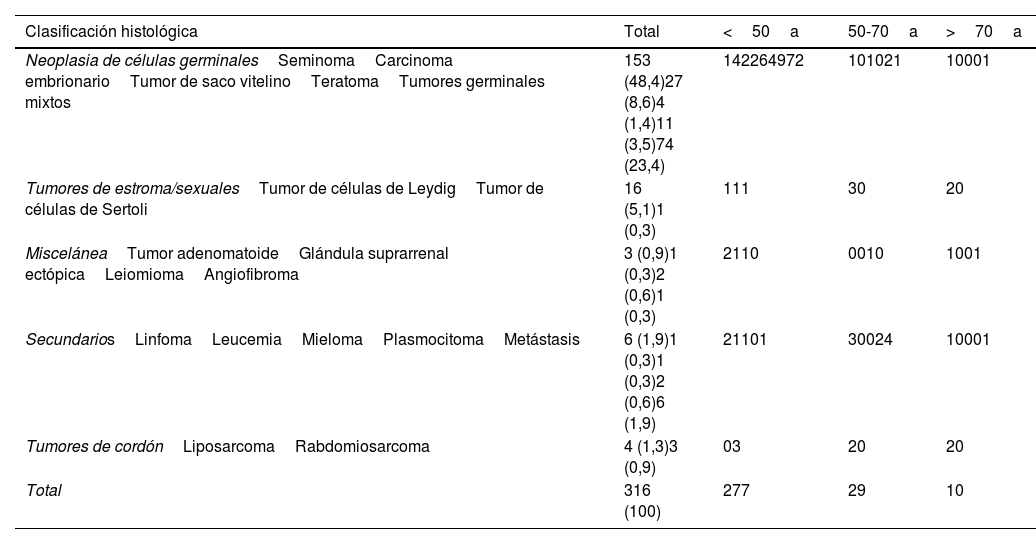Evaluar indicaciones e histología de nuestra serie de orquiectomías, analizando los resultados dependiendo de la edad del paciente.
MétodosEstudio de las orquiectomías realizadas en nuestro centro entre 2005 y 2020 a pacientes mayores de 18 años. Evaluamos: datos demográficos, indicaciones, histología y efectividad del diagnóstico ecográfico según 3 grupos de edad.
ResultadosSe realizaron 489 orquiectomías, 364 (74%) en los pacientes entre 18-50 años (grupo A), 59 (12%) entre los pacientes de 51-70 años (grupo B) y 66 (13,4%) en mayores de 70 años (grupo C). En el grupo A, 284 (78%) orquiectomías fueron indicadas por sospecha tumoral, 261/284 (91,9%) fueron neoplasias malignas, 253 (89%) germinales. La ecografía testicular tuvo un valor predictivo positivo (VPP) para tumor testicular maligno del 90%. En el grupo B, 34 (57%) orquiectomías fueron indicadas por sospecha tumoral y 25/34 (73,5%) presentaron neoplasias malignas. La ecografía tuvo un VPP para malignidad del 68%.
En el grupo C, la orquiepididimitis fue la causa más frecuente de orquiectomía con 30 casos (45,5%). Entre las 20 orquiectomías por sospecha de tumor (30,3%), se encontró malignidad en 6. La ecografía tuvo un VPP para malignidad del 31%.
ConclusiónEn menores de 70 años la indicación principal de orquiectomía fue la sospecha tumoral y en mayores, la orquiepididimitis. Los tumores germinales fueron la histología más frecuente en los menores de 70 años; en los mayores la malignidad fue infrecuente. Con la edad, disminuyó el VPP de la ecografía testicular para neoplasia maligna. En los mayores de 50 años se debería mejorar el proceso diagnóstico antes de indicar orquiectomía por sospecha tumoral.
To evaluate the indications and histology of our series of orchiectomies, analysing the results by patient's age.
MethodsWe included the orchiectomies realized in our hospital between 2005 and 2020 in patients older than 18 years. We estimated demographic data, indications, histology and effectiveness of testicular ultrasound by three groups of age.
ResultsWe included 489 orchiectomies, which 364 (74%) belonged to group A (patients between 18-50 years), 59 (12%) to group B (50-70 years) and 66 (14%) to group C (older than 70 years). In group A, 284 (78%) orchiectomies were indicated due to malignancy suspect. In 91.9% cases (261) malign neoplasm was confirmed at final histology and 253 (89%) were germinal cells. Testicular ultrasound had a positive predictive value (PPV) of 90% in this group. In group B, 34 (57%) orchiectomies were indicated because of malignancy suspect. At final histologic analysis, 25/34 (73.5%) confirmed malign neoplasm. Ultrasound had a PPV of 68%.
In group C, orchiepididymitis was the main cause of testicular removal with 30 cases (45,5%). From the 20 cases (30.3%) with suspicion of malignancy, only 6 had confirmed malign histology. Testicular ultrasound PPV for malignancy was 31%.
ConclusionIn patients younger than 70 years the main orchiectomy's indication was suspect of malignancy and in older than 70, testicular inflammation. The germinal neoplasm was the predominant histology in younger than 70 years. In older than that, malignancy was infrequent. The positive predictive value of testicular ultrasound for malignancy decreased with patient's age. In patients older than 50 years proper image diagnosis to assess malignancy should be considered before orchiectomy is done.














